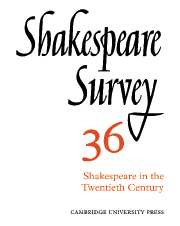Book contents
- Frontmatter
- Shakespeare and the Living Dramatist
- Blood and Wine: Tragic Ritual from Aeschylus to Soyinka
- Hamlet Andante/Hamlet Allegro: Tom Stoppard’s Two Versions
- Auden, Shakespeare, and the Defence of Poetry
- Graves on Lovers, and Shakespeare at a Lovers’ Funeral
- Tragic Balance in Hamlet
- Hamlet Across Space and Time
- Shakespeare’s Scripts and the Modern Director
- ‘He Shall Live a Man Forbid’: Ingmar Bergman’s Macbeth
- Komisarjevsky at Stratford-upon-Avon
- Troilus and Cressida and the Definition of Beauty
- The Pastoral Reckoning in Cymbeline
- New Created Creatures: Ralph Crane and the Stage Directions in The Tempest
- Arden of Faversham
- ‘Pickleherring’ and English Actors in Germany
- Shakespeare Performances in Stratford-upon-Avon and London, 1981–2
- The Year's Contributions to Shakespearian Study 1 Critical Studies
- 2 Shakespeare’s Life, Times and Stage
- 3 Textual Studies
- Index
- Plate Section
Shakespeare’s Scripts and the Modern Director
Published online by Cambridge University Press: 28 March 2007
- Frontmatter
- Shakespeare and the Living Dramatist
- Blood and Wine: Tragic Ritual from Aeschylus to Soyinka
- Hamlet Andante/Hamlet Allegro: Tom Stoppard’s Two Versions
- Auden, Shakespeare, and the Defence of Poetry
- Graves on Lovers, and Shakespeare at a Lovers’ Funeral
- Tragic Balance in Hamlet
- Hamlet Across Space and Time
- Shakespeare’s Scripts and the Modern Director
- ‘He Shall Live a Man Forbid’: Ingmar Bergman’s Macbeth
- Komisarjevsky at Stratford-upon-Avon
- Troilus and Cressida and the Definition of Beauty
- The Pastoral Reckoning in Cymbeline
- New Created Creatures: Ralph Crane and the Stage Directions in The Tempest
- Arden of Faversham
- ‘Pickleherring’ and English Actors in Germany
- Shakespeare Performances in Stratford-upon-Avon and London, 1981–2
- The Year's Contributions to Shakespearian Study 1 Critical Studies
- 2 Shakespeare’s Life, Times and Stage
- 3 Textual Studies
- Index
- Plate Section
Summary
The twentieth-century interpreter of Shakespeare’s plays faces significant problems. Perhaps most basic is the simple fact that the dialogue and stage directions are not directed at us. Thus, as R.B. McKerrow noted shrewdly over fifty years ago, Shakespeare’s original manuscript of Hamlet or King Lear ‘would not have been written with any thought of the press. It was not intended for the study, or for the minutediscussion of students three hundred years away in the future. It was not a literary document at all.’ Rather, as McKerrow argues, that original manuscript ‘was merely the substance, or rather the bare bones, of a performance on the stage, intended to be interpreted by actors skilled in their craft, who would have no difficulty in reading it as it was meant to be read’. Those manuscripts, then, were not literary texts but theatrical scripts, written to be interpreted and performed by Elizabethan theatrical professionals who shared with both author and spectator a common language that included not only the words themselves but also stage conventions, emblematic costumes and properties, and an overall logic of presentation that today we may no longer recognize or appreciate.
- Type
- Chapter
- Information
- Shakespeare Survey , pp. 57 - 64Publisher: Cambridge University PressPrint publication year: 1983

